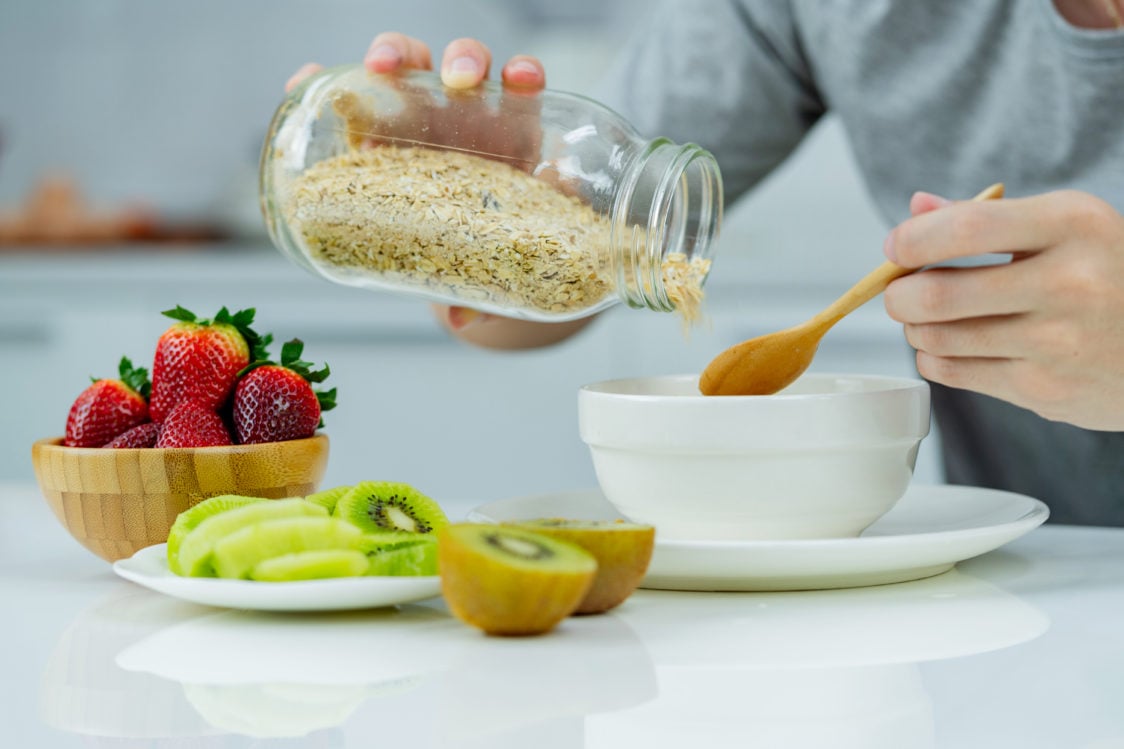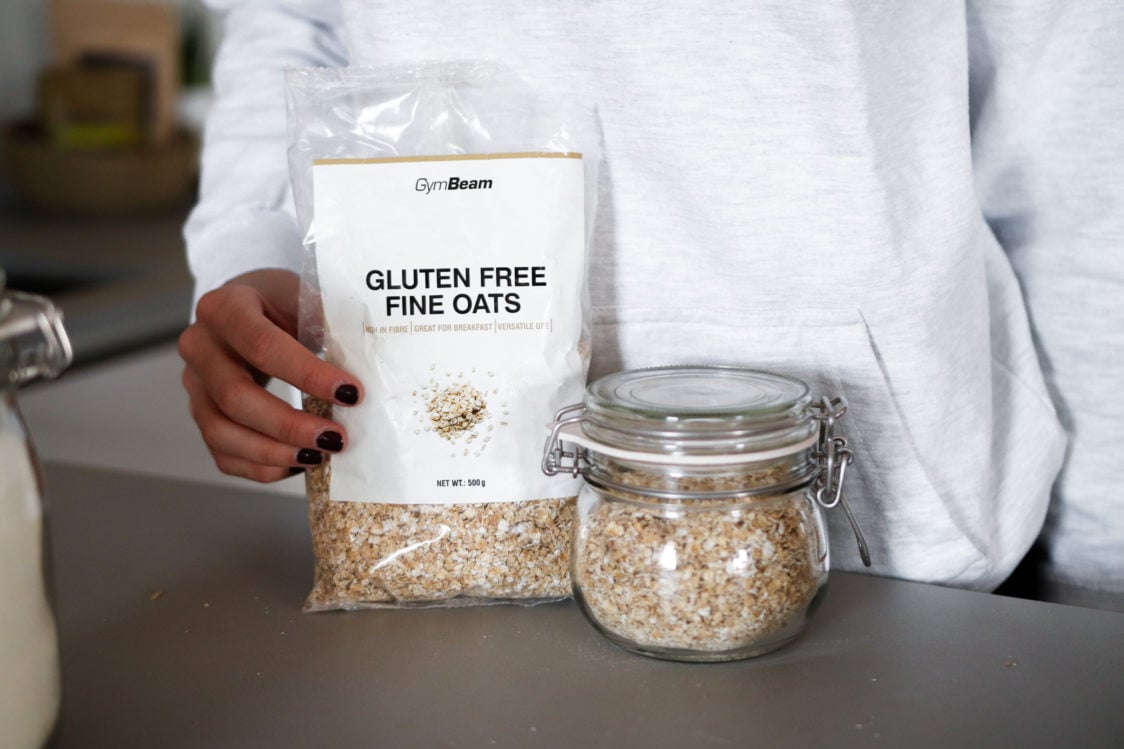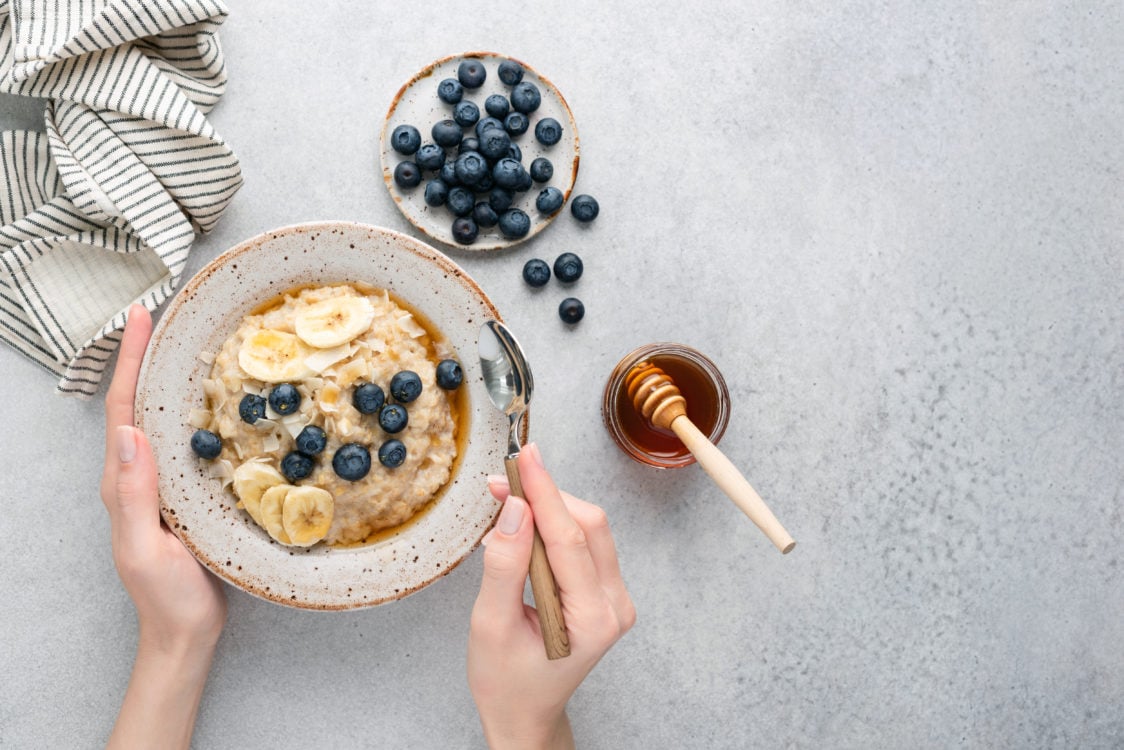Table of Contents
Many people cannot imagine a day without oats. It is a timeless and nutritionally rich food that has already survived all possible diet fads and is still a cornerstone of the diet of those who try to eat healthy. What do oats contain and what are their benefits? Today’s article will tell you more.
What makes oats stand out?
At first glance, oats are relatively boring food. But in fact, they are one of the most nutritious cereal product. They excel especially by the content of proteins and unsaturated fatty acids. They also contain a large amount of fibre, more specifically the beta-glucans. It is a soluble fibre, which not only has a beneficial effect on digestion, but also contributes to maintaining an optimal level of cholesterol in the blood and controlling the rise in blood sugar after a meal. [6]
There are countless ways to include oats in your diet. Thanks to neutral taste, they are suitable for both sweet and savoury recipes. Simple preparation will surely be appreciated by those who want to eat healthy, but have limited time to prepare their meals.
How much protein is in oats?
Cereals usually contain an average of 10 g of protein per 100 g. Oats have around 14 g of protein per 100 g. So if you prepare oatmeal for breakfast from 50 g of oats (protein content is approx. 7 g) and supplement it with, for example, 20 g of whey protein (contains approx. 15 g of protein), you can easily consume 22 g of protein.
The content of essential amino acids, i.e. those that your body cannot produce itself, is generally unbalanced in cereals. Therefore, cereals are not considered a complete source of protein. However, oats excel in protein quality. They have a better ratio of essential amino acids compared to other cereals, and its amino acid content is comparable with legumes. [5,8,10,16]
You can read more about plant protein sources in the article What Are the Best Sources of Plant Proteins and Why Include Them in Your Diet?

Are oats gluten-free?
This question is asked by everyone who follows a gluten-free diet for health or other reasons. Gluten is a protein made up of prolamins and glutelins. In a person with celiac disease, prolamins (e.g. gliadin in wheat) trigger immune processes that lead to damage to the intestinal mucosa. Cereals that must be eliminated in a gluten-free diet are wheat, rye and barley.
Oats are not gluten-free. However, oat prolamins (called avenins) have a different structure than wheat, rye and barley prolamins. For most people with celiac disease, these don’t cause any issues, so it doesn’t have to be eliminated from their diet. However, it is necessary to monitor the symptoms, because there are also some people who can suffer from abdominal pain and digestive problems after eating oats.
However, the issue is that oats are often contaminated with gluten from other cereals (wheat, rye, barley). Oats are processed together with other cereals on the same production lines, so contact with gluten may occur. That’s why the label might contain information that oats may contain “traces of gluten”. In reality, this means that the manufacturer provides this information as a precaution, as it is possible that the food contains gluten from other sources.
If it is written on the packaging that oats are “gluten-free”, the food contains a maximum of 20 mg of gluten per 1 kg of food. The label “very low gluten content” means that there is less than 100 mg of gluten in 1 kg of food. Gluten tolerance varies among celiacs, so everyone has to monitor the amount that is still acceptable for them. [11]
You might be interested in these products:
What about the fat content of oats?
Oats have a higher fat content than other cereals. They contain 5-10 g of fat per 100 g. Up to 80% of the fat content is made up of unsaturated fatty acids. Almost 40% is oleic acid and another 40% is linoleic acid, which is classified as an omega-6 fatty acid. The total composition of fat in oats is beneficial, especially from the point of view of cardiovascular health. [7,9]
However, the higher fat content is also responsible for faster spoilage of oats, so you must ensure that you store them properly.
How to store oats?
Store oats in a closed container in a cool, dark place. Make sure they are not wet and that no more air than necessary gets into the container. With proper storage, they will last for up to a year. However, if oats change their appearance, aroma, or moths or other pests get inside, it is better to throw them away and buy new ones. [12]
On the packaging, you can find the best before date. However, its expiration doesn’t mean that the food needs to be thrown away. Oats can be edible and safe even after this date if stored well. If you don’t notice any changes, you don’t have to be afraid to use them.
You can read more about food storage in the article How to Store Food Properly to Make It Last as Long as Possible.

How much carbohydrates and fibre are in oats?
There are approximately 60 g of complex carbohydrates (polysaccharides) in 100 g of oats. Thanks to their slow absorption into the blood, they ensure longer satiety and a slower onset of hunger.
Beta-glucans are typical for oats. It is a soluble fibre that is classified among the so-called prebiotics. Prebiotic fibre serves as food for beneficial intestinal bacteria. In addition, polysaccharides together with beta-glucans help to maintain a stable blood sugar level and thus successfully fight against sweet cravings. [6]
Oats contain up to around 11 g of fibre per 100 g. The recommended daily intake of fibre is 30 g. In a 50 g serving of oats you get 18% of the recommended daily fibre intake.
What vitamins and minerals are in oats?
In 100 g of oats, you get approximately 16% of the recommended daily intake of folic acid (also called vitamin B9). It is essential for the proper growth and development of the body, and pregnant women should take care of sufficient intake. They are also rich in some other B vitamins, such as vitamin B1 (thiamine), which positively affects functioning of your nervous system and heart. Oats also contain vitamin E, which has antioxidant effects. [13]
100 g of oats contains approximately twice the recommended daily dose of manganese, which is important for bone health. They are also a source of potassium, magnesium and iron. Potassium and magnesium are involved in the proper function of muscles and the nervous system. Iron ensures the transfer of oxygen, participates in the function of the immune system and is also important for the support of cognitive functions, such as concentration and memory. Oatmeal can thus be a great snack during a demanding working day. [1,13]
What is the energy value and nutrient content of oats?
Energy Value (kcal/kJ) | Carbohydrates | Protein | Fat | Unsaturated Fatty Acids | Fibre |
|---|---|---|---|---|---|
| 357 kcal / 1499 kJ | 55.7 g | 16.9 g | 6.9 g | 2.2 g | 10.6 g |
Folic Acid | Iron | Magnesium | Phosphorus | Potassium | Manganese | |
|---|---|---|---|---|---|---|
| 0.8 mg (72 % RDI*) | 56 μg (28 % RDI) | 4.7 mg (33 % RDI) | 177 mg (47 % RDI) | 523 mg (75 % RDI) | 429 mg (21% RDI) | 4.9 mg (245 % RDI) |
*Recommended Daily Intake [6]
Why eat oats?
- Due to the content of polysaccharides and fibre, oats have a high satiating capacity. Polysaccharides satiate more and for a longer period of time than simple carbohydrates (sugars), because they are digested more slowly and remain in the digestive tract for a longer time. The soluble fibre in oats (beta-glucans and other types of fibre) also binds water, which increases its volume and accelerates the onset of the feeling of satiety. [6]
- This makes oats an ideal food for weight loss. They help to satiate and fight off hunger, thanks to which you are likely to eat less food and lose weight easier.
- Polysaccharides and fibre also ensure a low glycemic index of oats. This means that after consuming them, the blood sugar level (glycemia) increases slowly. Small fluctuations in blood sugar levels are definitely desirable because they help control sweet cravings. At the same time, there is not that much fluctuation in the perceived energy. [6]
- However, the glycemic index is also affected by heat treatment of the food or, for example, by combining it with other nutrients. By adding proteins, fats and another source of fibre to oats, their glycemic index gets even lower. Oatmeal with water will increase glycemia faster (will have a higher glycemic index) than, for example, oats with yogurt, nuts and fruit. [14]
- In the digestive tract, beta-glucans (soluble fibre) acquire a gel consistency. Thanks to this, they can bind bile acids, which are part of the cholesterol absorption process, and increase their excretion. Oats can help prevent high cholesterol. Including it regularly in your diet can also help if your cholesterol is already high. In that case it is necessary to consume at least 3 g of beta-glucans daily. 100 g of oats contain 3-8 g of beta-glucans. [2,3,4]
- Fibre in oats serves as a prebiotic. It “feeds” intestinal bacteria and thus helps their reproduction, thereby contributing to a better composition of the intestinal microbiota. That’s also why it improves digestion and helps prevent constipation. However, having a healthy intestinal microbiota is also a good prevention of many diseases, such as colon cancer, type 2 diabetes mellitus or obesity. [6]

How to prepare oats?
There are many variations of oats available: coarse (unground), fine (ground), or sprouted oats. You can also find them processed into instant oatmeal or oat flour. All of the above have an endless number of uses and are suitable for both sweet and savoury dishes.
Sweet oats
- The most famous dish made from oats is definitely oatmeal. Whether you cook oatmeal with milk, water or make unsweetened instant oats, you have a great base for breakfast, or a larger snack. You can also break the tradition of oatmeal for breakfast and enjoy it for dinner, for example as a nutritious post-workout meal.
- Always supplement oats/instant oatmeal with protein (in the form of whey protein, plant-based protein, yogurt, quark, etc.) and add fruit, possibly even nuts, seeds or nut butter. If you need inspiration, you can try this instant protein oatmeal.
- Oats are a good addition to yogurts with some fruit and nuts. And if you fancy a change, you can replace fresh fruit with freeze-dried.
- Granola, which is made from oats, is also suitable for combining with yogurt or quark. If you prefer homemade granola, you can making granola with nuts and quinoa.
- For those who don’t have time in the morning, but want to prepare a tasty full breakfast: You can try soaking oats in milk or yogurt, leaving them overnight in the refrigerator and just finishing them off with some fruit or nut butter in the morning. Try, for example, coconut-cocoa oatmeal or oatmeal with pudding and chocolate crust.
- If you want to take the effects of oats to an even higher level, prepare fermented oatmeal. Cover oats with a white sour drink (kefir milk, acidophilus milk, buttermilk, etc.) and let stand for 8-12 hours at room temperature. Fibre in oats serves as food for microorganisms in sour drinks. They multiply during fermentation and the result is nutritious food that supports healthy intestinal microbiota. In addition, fermented oatmeal is better digestible and the nutrients in it are better utilised.
- You can also use oats or instant oatmeal to create a base for a cake. Try, for example, a Cake with coconut cream or a No-bake coconut cake.
- Oats are also suitable as a part of the dough for various cakes, pancakes and fritters. You will definitely like these banana pancakes, peanut slices or fruit crumble.

Savoury oats
- You can blend oats (or use fine oats) and use them to thicken soups and sauces.
- By adding oats to the dough when baking bread, you increase its nutritional value.
- Oatmeal also tastes great as a savoury dish. Just add some cottage cheese, herbs and vegetables. You can also try melting grated cheese in cooked oatmeal and add a hard-boiled or fried egg on top in addition to vegetables and herbs. For both sweet and savoury options, the possibilities are endless.
- You can also add oats to savoury muffins, patties or burgers, for example.
What should you remember?
Oats are definitely one of the most nutritious cereal grains. Not only are they rich in vitamins and minerals, but they also contain a decent amount of high-quality protein and fat. Their high fibre content helps with adjusting the composition of the intestinal microbiota, controlling cholesterol or blood sugar levels. Due to their high ability to satiate, they should be included in the diet of everyone who is trying to lose weight.
If you liked the article, don’t keep it to yourself and spread it by sharing it with your friends.
[1] DUYFF, R.L. Complete Food & Nutrition Guide. . New York: Academy of Nutrition and Dietetics, 2017. ISBN 978-0-544-52058-5.
[2] EFSA PANEL ON NUTRITION, NOVEL FOODS AND FOOD ALLERGENS (NDA) et al. Beta-glucans from oats and/or barley in a ready-to-eat cereal manufactured via pressure cooking and reduction of blood-glucose rise after consumption: evaluation of a health claim pursuant to Article 13(5) of Regulation (EC) No 1924/2006 – – https://onlinelibrary.wiley.com/doi/abs/10.2903/j.efsa.2021.6493
[3] EL KHOURY, D. et al. Beta glucan: health benefits in obesity and metabolic syndrome.– https://www.ncbi.nlm.nih.gov/pmc/articles/PMC3236515/
[4] JOYCE, S.A. et al. The Cholesterol-Lowering Effect of Oats and Oat Beta Glucan: Modes of Action and Potential Role of Bile Acids and the Microbiome. – https://www.ncbi.nlm.nih.gov/pmc/articles/PMC6892284/
[5] KLOSE, C. - ARENDT, E.K. Proteins in oats; their synthesis and changes during germination: a review. – https://pubmed.ncbi.nlm.nih.gov/22530714/
[6] PAUDEL, D. et al. A Review of Health-Beneficial Properties of Oats. – https://www.ncbi.nlm.nih.gov/pmc/articles/PMC8625765/
[7] RASANE, P. et al. Nutritional advantages of oats and opportunities for its processing as value added foods - a review. – https://www.ncbi.nlm.nih.gov/pmc/articles/PMC4325078/
[8] SINGH, R. et al. Avena sativa (Oat), a potential neutraceutical and therapeutic agent: an overview.– https://pubmed.ncbi.nlm.nih.gov/23072529/
[9] STERNA, V. et al. Oat Grain Composition and its Nutrition Benefice. – https://www.sciencedirect.com/science/article/pii/S2210784316301000
[10] A comparative study of the functionality and protein quality of a variety of legume and cereal flours.– https://onlinelibrary.wiley.com/doi/abs/10.1002/cche.10226
[11] Coeliac disease on the rise in Europe. – https://www.eufic.org/en/healthy-living/article/coeliac-disease-on-the-rise-in-europe
[12] Dry oatmeal needs careful handling.– https://www.canr.msu.edu/news/dry_oatmeal_needs_careful_handling
[13] EU Register of nutrition and health claims made on foods (v.3.6). – https://ec.europa.eu/food/safety/labelling_nutrition/claims/register/public/?event=search
[14] Glycemic index for 60+ foods. – https://www.health.harvard.edu/diseases-and-conditions/glycemic-index-and-glycemic-load-for-100-foods
[15] Oats Nutrition Facts & Calories. – https://nutritiondata.self.com/facts/cereal-grains-and-pasta/5708/2
[16] Processing Oats and Bioactive Components.– https://www.sciencedirect.com/science/article/pii/B9780124046993000433


Add a comment